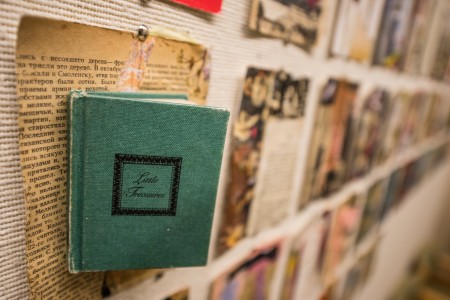
Where destruction occurs, a new form of life comes to fruition. At least that’s the premise of the War and Peace Project currently exhibited in the Burling Library basement.
Almost 30 years after her graduation from Grinnell with a Russian Studies major, Laura “Lola” Baltzell ’83 felt inspired to pay homage to one of her favorite novels, which she studied in college by creating collages on the 747 ripped pages of her Russian copy of “War and Peace.” She bought the first of many copies of Tolstoy’s magnum opus while spending one of her collegiate summers in former Leningrad, now St. Petersburg.
Baltzell said the project was conceived in late 2009 after one particular instance when Lucy Arrington, one of the collaborators on the project, told her about the “One Drawing for Every Page of Moby Dick” blog.
Baltzell said that after finding out about the aforementioned blog, she was inspired to rip pages from the novel and create the project now known as the War and Peace Project by the quotation from Tolstoy’s work, “Yes, that death is an awakening.”
Baltzell said she felt compelled to start an art project of her own in her area of expertise: collage-making. After Baltzell created six of the collages herself, she said she thought the project would be more enjoyable with a group of artists, given the scale of the project. Thus, Team Tolstoy was created.
In early 2010, Team Tolstoy was comprised of four artists and the photographer who indexed the process of the project. At the project’s completion, the group was made up of eight talented artists, five of whom graduated from Grinnell around the same time as Baltzell: Otto Mayr ’82, and Christiane Carney Johnson, Lucy Zahner Montgomery, Elizabeth Jorganson Sherman and Lynn Waskelis (all ’83).
For two and a half years, five members of Team Tolstoy met every Friday afternoon in their East Boston studio to work on the collages. Team Tolstoy mailed the remainder of the team and their guest artists each a different page of the book on which they could work.
The project had only three rules: each collage must have at least one word from the original text, once the collage was done, no artist was allowed to retouch or redo the collage and each artist was allowed to choose whether they wanted to respond to the novel’s storyline in their work.
Other than the original Russian text, the collages were made on vellum paper with an assortment of materials, including hand-me-down books, pamphlets, thread, dried flowers, wax, inks and graphite.
Once completed, the War and Peace Project became one of the “most fulfilling and exciting things” Baltzell has ever done in her life, according to her blog.
Since the completion of the project, it has been shown in several parts of the world. A portion of the War and Peace Project debuted in Boston in 2010. The entire project debuted in Russia at the Leo Tolstoy Museum Estate and the Moscow Book Fair, where it was well-received.
Baltzell confessed that she was worried the project would not be well-received by the people in charge of the Leo Tolstoy Museum Estate because the project involved ripping pages from the novel. However, the estate’s curators thought the project was a brilliant method to breathe new life into the 1869 novel and hopefully attract a younger audience, and immediately agreed to host it.
During her time in Russia, Baltzell attended the opening reception with six other artists. She and Team Tolstoy also hosted several workshops for the Russian audience in which they taught the audience a collaborative collage-making process.
Subsequently, the project has been show at the University of Massachusetts, Amherst and the University of Arkansas, Fayetteville.
Interested students who want to know more about the project and individual collages can visit the blog, warpeaceproject.blogspot.com, where all 747 collages are published alongside comments from the artists.
























































